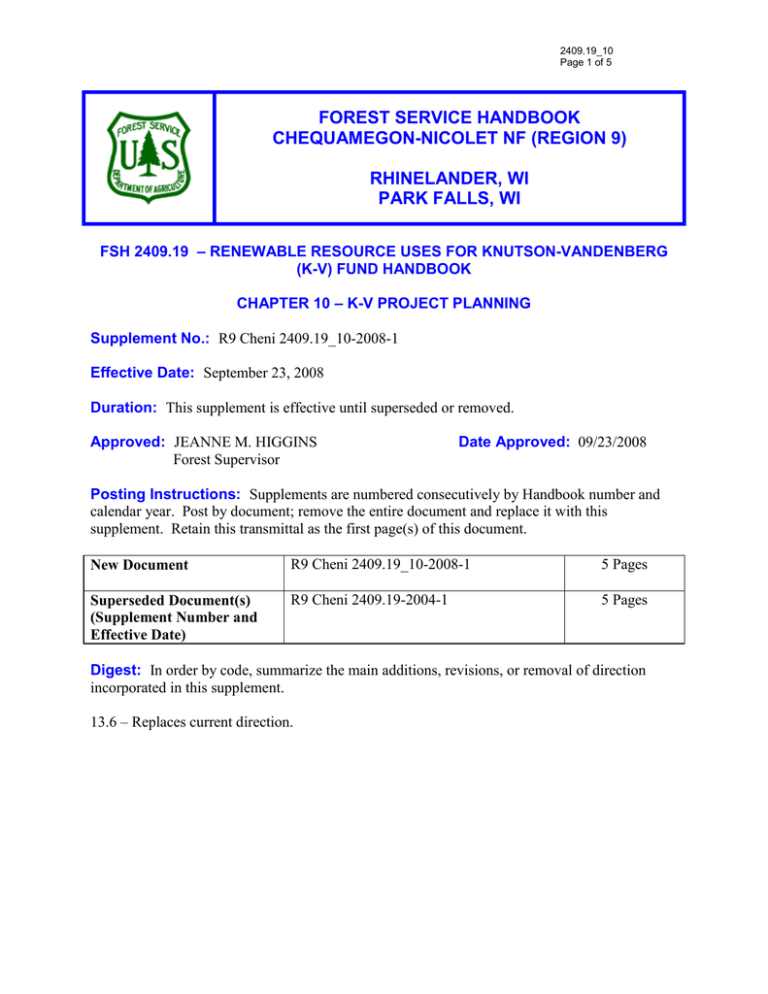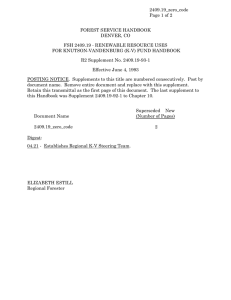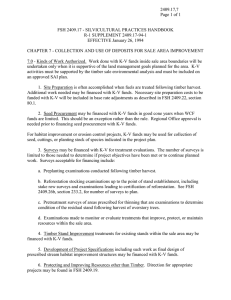FOREST SERVICE HANDBOOK CHEQUAMEGON-NICOLET NF (REGION 9) RHINELANDER, WI
advertisement

2409.19_10 Page 1 of 5 FOREST SERVICE HANDBOOK CHEQUAMEGON-NICOLET NF (REGION 9) RHINELANDER, WI PARK FALLS, WI FSH 2409.19 – RENEWABLE RESOURCE USES FOR KNUTSON-VANDENBERG (K-V) FUND HANDBOOK CHAPTER 10 – K-V PROJECT PLANNING Supplement No.: R9 Cheni 2409.19_10-2008-1 Effective Date: September 23, 2008 Duration: This supplement is effective until superseded or removed. Approved: JEANNE M. HIGGINS Forest Supervisor Date Approved: 09/23/2008 Posting Instructions: Supplements are numbered consecutively by Handbook number and calendar year. Post by document; remove the entire document and replace it with this supplement. Retain this transmittal as the first page(s) of this document. New Document R9 Cheni 2409.19_10-2008-1 5 Pages Superseded Document(s) (Supplement Number and Effective Date) R9 Cheni 2409.19-2004-1 5 Pages Digest: In order by code, summarize the main additions, revisions, or removal of direction incorporated in this supplement. 13.6 – Replaces current direction. R9 CHENI SUPPLEMENT 2409.19_10-2008-1 EFFECTIVE DATE: 09/23/2008 DURATION: Effective until superseded or removed 2409.19_10 Page 2 of 5 FSH 2409.19 – RENEWABLE RESOURCE USES FOR KNUTSON-VANDENBERG (K-V) FUND HANDBOOK CHAPTER 10 – K-V PROJECT PLANNING 13 – APPROPRIATE USE OF K-V FUNDS 13.6 – Priorities for the Use of K-V Funds The National Forest Management Act of 1978 amended the Knutson-Vandenberg Act to provide for collection of K-V funds from the sale of timber for timber management activities and other activities needed to protect and improve the future production of renewable resources on timber sale areas (FSM 2477). In accordance with FSM 2609.13, non-silvicultural resource activities include, but are not limited to, planting or seeding plants for wildlife food and cover, prescribed burning, construction and improvement of watch catchments and springs, stream cleanout, seeding non-System roads and manipulation of vegetation to enhance wildlife and fish habitat. This supplement lists, by priority groups, suggested projects to be considered when completing SAI plans on the Chequamegon-Nicolet National Forest. The list is not all inclusive. Procedure A. Wildlife and fish habitat improvement projects will be given consideration in all SAI plans, along with timber and other resource needs. B. The line officer is responsible for determining the priorities for funding K-V projects on an individual timber sale. First priority for available funding will be given to reforestation projects. C. All SAI plans should be reviewed on the District by the person responsible for managing the wildlife and fish resource. 1. Assure that all reasonable opportunities to improve the wildlife and fish habitat on the sale area have been considered. 2. Assure that project costs are in line with similar P&M project costs. Keep in mind that direct and indirect overhead, from the Washington Office through district program management, is assessed on all K-V projects, as per financial management direction. D. K-V funds cannot be used to maintain physical structures (dams, nest boxes, stream structures, etc.). E. K-V funding should be used as needed to improve production of the renewable resources. It should be considered a supplement to, rather than a replacement for, construction, protection, and maintenance of resource improvements. All proposed activities should have interdisciplinary input and must be covered by F. R9 CHENI SUPPLEMENT 2409.19_10-2008-1 EFFECTIVE DATE: 09/23/2008 DURATION: Effective until superseded or removed 2409.19_10 Page 3 of 5 FSH 2409.19 – RENEWABLE RESOURCE USES FOR KNUTSON-VANDENBERG (K-V) FUND HANDBOOK CHAPTER 10 – K-V PROJECT PLANNING a NEPA decision. G. As with timber, only lands within the timber sale area are eligible for any type of K-V funded projects. Extension of sale boundaries so as to include an area in need of habitat improvement is not permitted. Priority Listing The priority listing should be considered in the following manner. As a general rule, if there is no Priority I work to be done in the particular sale area, then consider projects from the Priority II group. If there are no Priority II projects, then consider Priority III and so on. However, if for some reason a project in a lower priority group is important on a particular sale area, it may be considered above a higher priority. Projects listed within the priority groups are not necessarily prioritized. A. Priority I Projects 1. Protection or enhancement of habitats for species classed as threatened or endangered by the State of Wisconsin or the Federal Government, and those classed as sensitive on the Chequamegon-Nicolet National Forest. a. b. 2. Upland Habitat Improvement a. b. 3. Close roads or control access to protect sensitive areas for listed animals and plants. Create and/or place coarse woody habitat elements in stands lacking such. Construct or create openings in accordance with Forest Plan or existing interim direction. Construction may include clearing, leveling, seeding, and/or fertilizing. Creation may include timber harvest, roller chopping and/or prescribed fire. Treatment of existing natural openings being invaded with woody vegetation or enlarging small openings with prescribed fire, herbicides, mechanical manipulation or hand tools (restoration). Aquatic Habitat Improvement a. b. Underplant with long-lived species in stands adjacent to streams and lakes. Depending upon soils, consider white spruce, black spruce, ash, oak, hemlock, cedar, white pine or red pine. Provide adequate drainage, particularly at road/stream crossings R9 CHENI SUPPLEMENT 2409.19_10-2008-1 EFFECTIVE DATE: 09/23/2008 DURATION: Effective until superseded or removed 2409.19_10 Page 4 of 5 FSH 2409.19 – RENEWABLE RESOURCE USES FOR KNUTSON-VANDENBERG (K-V) FUND HANDBOOK CHAPTER 10 – K-V PROJECT PLANNING c. d. B. Priority II Projects 1. Upland Habitat Improvement a. b. c. d. e. 2. Restore and/or maintain frost pocket/barrens habitat by prescribed fire, mechanical manipulation or planting of native vegetation. Prescribed burn or utilize mechanical manipulation to create an early successional stage needed by certain wildlife species. Release oak or other mast trees to stimulate growth and/or crown development, if not possible with timber sales. Seed haul roads following close of sale. Consider hunter walking areas only in suitable habitat. Install hunter walking trail gates as needed and appropriate. Aquatic Habitat Improvement a. b. c. d. C. on haul roads. Focus efforts to areas where the road is contributing sediment into the aquatic system or blocking fish/animal movement. Place wood (tree-drops, cribs, ½ logs) in lakes and streams to restore critical habitat for aquatic organisms. Restore or enhance wetland habitat by prescribed burning, mechanical manipulation or planting of native species. Place or create waterfowl nest boxes, colonial waterbird nesting platforms and loafing sites in suitable habitat. Suggested rate: one box per acre of suitable brood habitat. Barrier (logs, beaver dams, etc.) removal to allow fish movement and improve stream flow on trout streams with an approved Stream Habitat Improvement Plan. Brush and/or aspen removal along trout streams. Place brush bundles in streams to restore channel integrity. Use a variety of techniques to restore habitat complexity within a stream or river system for cold, cool and warm water aquatic species. Priority III Projects 1. Upland Habitat Improvement a. Create natural or place artificial roosting or nesting boxes for species that require this habitat. R9 CHENI SUPPLEMENT 2409.19_10-2008-1 EFFECTIVE DATE: 09/23/2008 DURATION: Effective until superseded or removed 2409.19_10 Page 5 of 5 FSH 2409.19 – RENEWABLE RESOURCE USES FOR KNUTSON-VANDENBERG (K-V) FUND HANDBOOK CHAPTER 10 – K-V PROJECT PLANNING b. c. 2. Aquatic Habitat Improvement a. D. Plant shrubs or fruit trees along the edge of openings or in small blocks; underplant suitable sites with oak, clumps of cedar and hemlock for wildlife food and cover. Restoration of fruit-producing trees. Placement of aeration systems in lakes to help control winterkill or structures in lakes and streams to improve fish habitat where an approved Habitat Improvement Plan exists. Priority IV Projects 1. Upland Habitat Improvement a. 2. Construct vernal pools/seasonal wetlands if proper physical conditions exist and lack of surface water warrants need. Consult Forest Biologist. Wetland Habitat Improvement a. Deepen, by dredging or blasting, small wetlands (potholes) to provide surface water. Consider only when pothole is within onequarter mile of permanent body of water having an adequate brood cover.

